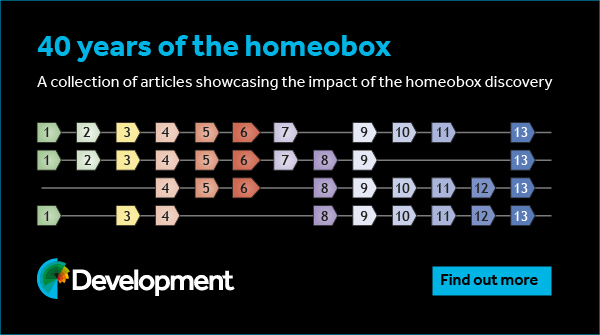The homeobox – 40 years of discovery
Posted by the Node, on 2 April 2024
This is an Editorial in Volume 151, Issue 6 of Development, written by Alex Eve and Oliver Hobert.
This year, 2024, marks the 40th year of the discovery of the homeobox, a landmark discovery that fundamentally impacted multiple fields, ranging from genetics and genomics to developmental biology, neuroscience and evolution. The application of molecular biology techniques to analyze mutant animals, beginning in the 1980s, allowed two laboratories on two different continents to independently find that classic Drosophila mutants with characteristic developmental patterning defects carried sequence alterations in specific genetic loci which shared an ∼180 nucleotide sequence called the ‘homeobox’. This name arose from the intriguing phenotypic alterations observed in homeobox gene mutants, namely the transformation of the identity of some body part into that of another body part. Such identity transformations had long been known to exist in animals and plants, and had been dubbed ‘homeotic transformations’ by William Bateson, one of the fathers of modern-day genetics. The first Drosophila mutants with such a transformation were first identified by Calvin Bridges in Thomas Hunt Morgan’s legendary Fly Room at Columbia University, and further characterized by Ed Lewis at Caltech, whose work on homeobox genes earned him the Nobel Prize in 1995. After the molecular identification of homeobox genes in 1984 by Michael Levine and Bill McGinnis in Walter Gehring’s lab in Switzerland (McGinnis et al., 1984) and Matt Scott and Amy Weiner in Thomas Kaufman’s lab in the USA (Scott and Weiner, 1984), it quickly became clear that the homeobox encoded a DNA-binding domain, the so-called homeodomain. The monumental impact of defining the homeobox genes did not merely lie in understanding how specific developmental patterning events are genetically specified in Drosophila, but it rather lay in the realization that this domain is conserved throughout the animal kingdom and, eventually, that not only their sequence but also their function in developmental patterning is conserved. In fact, homeobox genes exist in unicellular organisms, but their number exploded with the advent of multicellularity, indicating that they have served as key drivers in the generation of the astounding complexity of animal body plans and cell types.
Another striking realization that came from studies across the animal kingdom was that homeobox genes form a part of a large family of genes encoding transcription factors, only a subset of which control developmental patterning along the anterior-posterior axis of a developing embryo (the genomically clustered HOX genes). Meanwhile, a much larger set of homeobox genes are involved in controlling the development of several other cell types, most notably and perhaps most predominantly so, the nervous system. Such neuronal functions of homeobox genes are deeply conserved in animals.
To celebrate this anniversary, Development has commissioned a series of review-type articles from leaders in the field demonstrating the impact that the homeobox discovery has had on different disciplines. This series, published throughout 2024, begins in this issue with two first-hand Perspectives that reflect on ‘perhaps the most exciting aspect of the homeotic gene story’ (Heasman et al., 1985): the first evidence that the Drosophila homeobox sequence is conserved in other animal species.
In the first article, Matthew Scott lays out the historical context for the discovery following studies of the Drosophila homeotic genes and describes from personal experience the work from Indiana University, USA, in identifying a conserved homeobox sequence (Scott, 2024). In its companion piece, Bill McGinnis and Michael Levine reminisce on their own ‘eureka moment’ from their studies in Basel, Switzerland, showing that the Drosophila homeobox sequence is conserved in other animals (McGinnis and Levine, 2024). Together, both Perspectives provide a fascinating and entertaining read, capturing the excitement of discovery and the maturation of competition into lifelong friendships.
To read the series as it grows, please visit the dedicated subject collection here: https://journals.biologists.com/dev/collection/10249/40-years-of-the-homeobox. To date, Development has published almost 5000 articles on homeobox genes and, of course, we welcome your future submissions detailing how this remarkable family functions in development, stem cells and regeneration.



 (2 votes)
(2 votes)